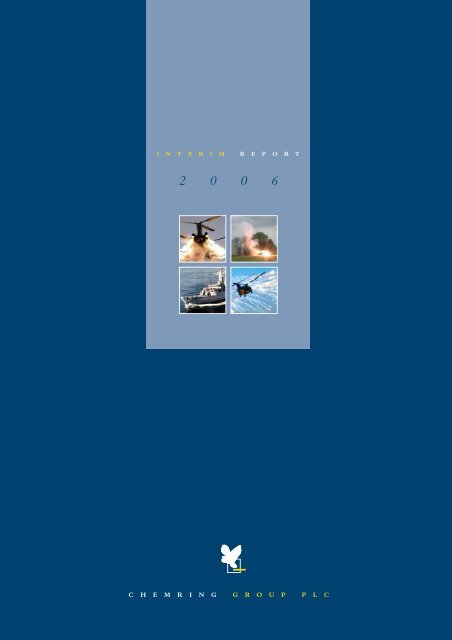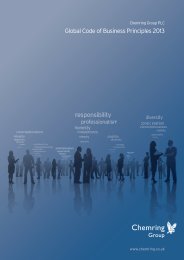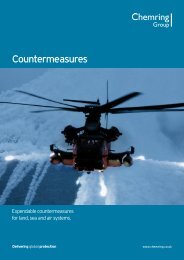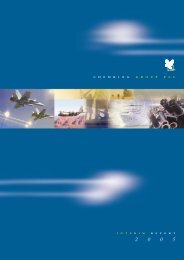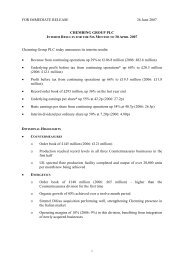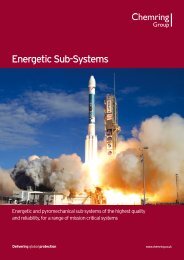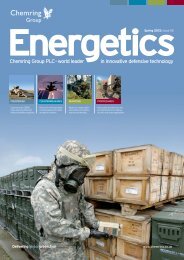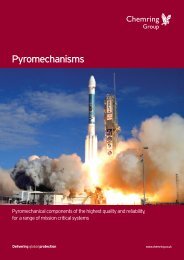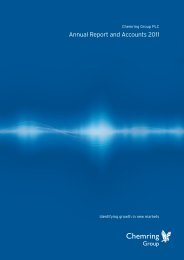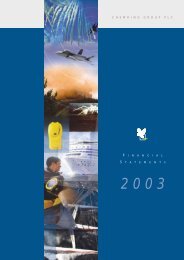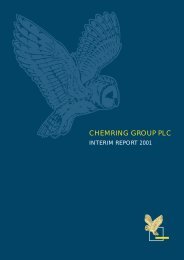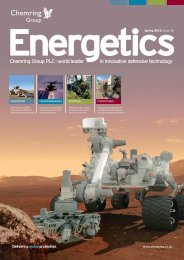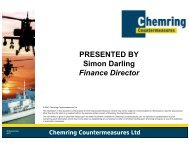Chemring Interim 2006 - Chemring Group PLC
Chemring Interim 2006 - Chemring Group PLC
Chemring Interim 2006 - Chemring Group PLC
You also want an ePaper? Increase the reach of your titles
YUMPU automatically turns print PDFs into web optimized ePapers that Google loves.
I N T E R I M R E P O R T2 0 0 6C H E M R I N G G R O U P P L C
C H E M R I N G G R O U P P L C
I N T E R I M R E P O R T 2 0 0 6Contents■ Statement by the Chairman2■ Unaudited Consolidated Income Statement6■ Unaudited Consolidated Balance Sheet7■ Unaudited Consolidated Cash Flow Statement8■ Independent Review Report by the Auditors10■ Notes to the <strong>Interim</strong> Statement11P 1
C H E M R I N G G R O U P P L CStatement by the ChairmanI am pleased to report that the <strong>Group</strong>has had an outstanding first half. Oncontinuing operations, operating profitincreased by 69% to £14.4 million(2005*: £8.5 million) and profit beforetax increased by 64% to £11.8 million(2005*: £7.2 million).Basic earnings per share increased by81% to 26.02p (2005*: 14.38p).Adjusted earnings per share, which hasbeen calculated to exclude the impactResults for the half year to 30 April <strong>2006</strong>Continuing operations:<strong>2006</strong> 2005*£m £mRevenue 82.6 48.0Operating profit 14.4 8.5Finance expense (2.6) (1.3)Profit before tax 11.8 7.2Basic earnings per share 26.02p 14.38pAdjusted earnings per share** 27.74p 14.62pof non-cash settled share-basedpayments and amortisation on acquiredintangibles, increased by 90% to 27.74p(2005*: 14.62p).The <strong>Group</strong> generated positiveoperating cash flow from operations of£13.4 million, compared to an outflowof £2.0 million in the first half of2005.The acquisitions in the periodwere partially funded by approximately£29.5 million of new debt, and hencenet debt at the end of the first halfincreased to £75.4 million(2005*: £39.7 million).Four acquisitions were completedduring the period - Comet inGermany,Technical Ordnance in theUS, and Leafield Engineering andLeafield Marine in the UK.Theycontributed £9.7 million of revenueand £1.2 million of operating profit tothe <strong>Group</strong> in the first half.Theintegration of these businesses withinour Energetics division, together withNobel Energetics acquired in September2005, is now well under way.The conditional sale of the non-coreMcMurdo marine lights business for£2.85 million cash was announced on30 May <strong>2006</strong>.The sale should becompleted on 30 June <strong>2006</strong>.P 2
I N T E R I M R E P O R T 2 0 0 6The Board wishes to continue with itsprogressive dividend policy, whilstbalancing the <strong>Group</strong>’s debt/equity ratioand managing cash requirements to fundexpansion, including small acquisitions.Accordingly, the directors haverecommended an interim dividend of4.80p per ordinary share (2005*: 3.20p),an increase of 50%.The interim dividendwill be paid on 15 August <strong>2006</strong> toshareholders on the register at28 July <strong>2006</strong>.Forward exchange currency contractshave been entered into to reduce the<strong>Group</strong>’s exposure to depreciation of theUS dollar against sterling.As I reported in my last statement, themediation with our former insurancebroker,Willis, was unsuccessful.Wetherefore continue to prepare forfull-scale litigation to recover thesignificant sums which we believe aredue to us.COUNTERMEASURESThe <strong>Group</strong>’s Countermeasures division,which still commands more than 50% ofthe world market for expendablecountermeasures, has continued itsremarkable profit growth, with Kilgorequadrupling its profits, Alloy Surfaces up51%, and <strong>Chemring</strong> Countermeasuresup 32% over the first half of last year.Demand for Alloy Surfaces’ specialmaterial decoys is unabated, and salesvolumes have increased by 72%compared with 2005.The extension toAlloy Surfaces’ second facility wascompleted in early June <strong>2006</strong>, and thecompletion of the new third facility ison target to enable production tocommence in November <strong>2006</strong>.Our production build-up has, to date,met all of the US Army productionmilestones.For the first time since it was acquiredby the <strong>Group</strong> in 2001, Kilgoregenerated a strong first halfperformance on the back of consistentvolume manufacture. Productionperformance on its high volumedecoys has improved significantly, andproduction rates of over 8,000 units aday are being achieved. A new largeflare facility to supply additional flaresto the US Air Force is being built, andproduction will commence in thesecond half of the year.In the UK, <strong>Chemring</strong> Countermeasureshad a solid performance, with asubstantial increase in demand fromthe UK Ministry of Defence tosupport peacekeeping operations inAfghanistan.The company has alsobeen successful in capturing severalimportant NATO contracts for navalcountermeasures.The Department of HomelandSecurity (DHS) in the US, to which Ihave referred in previous reports, isnow searching for alternative solutionsto the laser systems initially selected astheir preferred method of protectingcommercial aircraft. Alloy Surfaces’special material decoys have beenselected by several systems providers asan integral part of the alternativesolutions which are now beingpresented to the DHS.ENERGETICSThis division had a solid start to itsfirst full year of operation, with each ofthe businesses in the division tradingprofitably.The majority of businessesmet expectations, and any shortfallswhich arose were purely attributable totiming issues, which are common withdefence contracts, and will berecovered in the second half of the year.PW Defence had an excellent start to<strong>2006</strong>, with sales volumes up 41%compared with the first half of 2005,principally driven by the peacekeepingrequirements of several countries,including the UK. Several large NATOcontracts for battlefield simulationproducts were secured, and the start-upof low-cost manufacturing in Estoniawas successfully completed.Comet also had a very good start, withorders from the US Army forbattlefield simulation products andfrom the French Army for its PEMBSP 3
C H E M R I N G G R O U P P L Cminefield clearance system.There isconsiderable interest in this systemfrom other nations involved inpeacekeeping operations for dealingwith either deployed mines orImprovised Explosive Devices.Two key development programmescompleted major milestones in the lastfew months. Nobel Energeticscompleted the final development ofthe rocket motors for the NLAWanti-armour missile. Kilgore alsocompleted the update of its marinelocation marker, with successfulqualification trials from both F/A-18and helicopter platforms, and full scaleproduction will get underway in thesecond half of the year.MARINE ELECTRONICSIn line with our stated strategy todivest the marine division, weannounced the conditional sale of theMcMurdo marine lights business for£2.85 million in May. I hope that,when I report to you next, I will beable to confirm that we have disposedof the residual marine electronicsbusiness at a satisfactory valuation.BOARD OF DIRECTORSIn May, the Board was delighted towelcome the Rt Hon Lord Freeman asa non-executive director, completing,for the moment, the restructuring ofthe Board. Lord Freeman has a wealthof experience in Government, thedefence industry, business and finance,and we consider ourselves fortunate tohave secured his services. He willassume the Chairmanship of the AuditCommittee in July.INTERNATIONAL FINANCIALREPORTING STANDARDSWe have adopted InternationalFinancial Reporting Standards(IFRS) in the first half of <strong>2006</strong> andhave consequently restated the priorperiod accounts. Full details of therestatements upon adoption of IFRSP 4
I N T E R I M R E P O R T 2 0 0 6have been published in notes 8 and 9with my statement today.PENSIONSIn earlier reports, I have referred to thework being done by the <strong>Group</strong> toprovide satisfactory, modern pensionarrangements for its UK employees,and to eliminate any actual ortheoretical gap which might existbetween the asset and liabilityvaluations of our defined benefitschemes. I repeat my previousassertions that any assessment of adeficit in the funding positions of theseschemes, taking into consideration theadditional contributions being made bythe <strong>Group</strong> every year, would beminimal and not material in thecontext of the <strong>Group</strong>.The strength ofthe <strong>Group</strong>’s covenant is recognised byvirtue of the fact that we have beenassessed at the lowest risk level by thePension Protections Fund in collectingits levy this year.The Board has however beenconsidering all aspects of the currentpensions debate, including possiblecorporate governance implications,where we have concerns at theapparent contradictions which nowexist between the various parties’responsibilities for pension schemes.The Board has a responsibility toensure that the defined benefitschemes are properly funded, andfollowing the adoption of IFRS, tomanage the liability representing thedeficit on the <strong>Group</strong>’s balance sheet.We are in discussions with allinterested parties to develop asatisfactory solution to this issue.PROSPECTSYour directors are very conscious ofthe current political-military scenario,not only in Iraq and Afghanistan butalso in other disturbed areas of theworld, and its potential impact on thegrowth of the <strong>Group</strong>.To the extentthat anyone can predict world events,the Board takes soundings in theappropriate quarters on its judgmentfor future strategy and the anticipatedrate of expansion of the <strong>Group</strong>. In ourpredominant niche ofcountermeasures, the Board isconfident that our expansion willcontinue for several years, both inconventional magnesium-based decoysand in Alloy Surfaces’ special materialdecoys.The commissioning of theextension to Alloy Surfaces’ secondfacility earlier this month, and theopening of the third facility inNovember <strong>2006</strong>, will provide theadditional capacity to meet the currentstrong order book.In our Energetics activities, we areconvinced that there are significantopportunities for expansion,consolidation and rationalisation, withthe resultant improvements inefficiency and global marketingcapabilities.The second half willbenefit from a full six months’contribution from Comet,Technical Ordnance and Leafield.In recent reports I have predictedbuoyant prospects for the <strong>Group</strong>,which the executive management havesuccessfully delivered. I anticipate thatthe full year results will demonstratefurther the <strong>Group</strong>’s potential, ourgrowing presence in the defenceindustry worldwide, and our ability togenerate value for our shareholders.K C ScobieChairman27 June <strong>2006</strong>*All comparisons are for the half year to 30 April 2005 restated for IFRS.** See note 5 of interim statement.P 5
C H E M R I N G G R O U P P L CUnaudited Consolidated Income Statementfor the half year to 30 April <strong>2006</strong>Continuing operationsRevenueNote2UnauditedHalf year to30 April <strong>2006</strong>£00082,584UnauditedHalf year to30 April 2005As restated£00047,977UnauditedYear to31 Oct 2005As restated£000120,963Operating profitShare of results of associateFinance expense214,351-(2,587)8,522-(1,329)22,050197(2,964)Profit before taxationTax411,764(3,830)7,193(2,295)19,283(5,724)Profit after taxation for the period/yearfrom continuing operations27,9344,89813,559Discontinued operationsLoss after taxation for the period/yearfrom discontinued operations2(129)(720)(4,790)Profit after taxation for the period/year7,8054,1788,769Attributable to:Equity shareholdersMinority interests7,80324,17268,75613Basic earnings per ordinary share526.02p14.38p29.88pDiluted earnings per ordinary share525.81p14.33p29.75pDividend per ordinary share4.80p3.20p10.50pConsolidated Statement of RecognisedIncome and Expensefor the half year to 30 April <strong>2006</strong>UnauditedHalf year to30 April <strong>2006</strong>£000UnauditedHalf year to30 April 2005As restated£000UnauditedYear to31 Oct 2005As restated£000Foreign currency translation differences on net investmentsActuarial gain/(loss) on retirement benefit scheme assetsHedging reserveTax on items taken directly to equityProfit after taxation for the period/year attributable toequity shareholders(2,529)4,420619(1,512)9987,803(2,708)(1,887)-572(4,023)4,17267(4,074)-1,348(2,659)8,756Total recognised income and expense8,8011496,097P 6
I N T E R I M R E P O R T 2 0 0 6Unaudited Consolidated Balance Sheetas at 30 April <strong>2006</strong>Non-current assetsIntangible assetsDevelopment costsGoodwillProperty, plant and equipmentInvestment in associateDeferred tax assetNoteUnauditedAs at30 April <strong>2006</strong>£0008,36667669,30556,6321,0656,432UnauditedAs at30 April 2005As restated£000-2,57527,98442,2361,0736,674UnauditedAs at31 Oct 2005As restated£0002,92954134,68050,6981,0687,440142,47680,54297,356Current assetsInventoriesTrade and other receivablesDerivative financial instrumentsCash and cash equivalentsAssets classified as held for sale37,51835,01347010,02315,15431,12329,927-327-27,82127,168-7,77414,64698,17861,37777,409Current liabilitiesLoansObligations under finance leasesBank overdraftsTrade and other payablesCorporation taxLiabilities classified as held for sale(6,396)(874)(7,456)(35,570)(1,363)(1,813)(4,388)(915)(12,477)(25,155)(1,932)-(1,957)(925)(10,744)(25,248)(1,150)(1,776)(53,472)(44,867)(41,800)Non-current liabilitiesLoansObligations under finance leasesOther payablesDeferred tax liabilitiesLong-term provisionsPreference sharesRetirement benefit obligations(70,271)(458)(209)(9,846)-(62)(16,762)(21,519)(733)(81)(5,288)(170)(62)(18,051)(46,320)(602)(163)(8,958)(170)(62)(20,189)(97,608)(45,904)(76,464)Net assets89,57451,14856,501EquityShare capitalShare premium accountSpecial capital reserveHedging reserveRevaluation reserveRetained earnings1,61153,52412,9394331,64019,1481,45526,94012,939-1,6697,8751,45927,27412,939-1,64012,912Equity attributable to equity holders of the parent89,29550,87856,224Minority interest279270277Total equity689,57451,14856,501P 7
C H E M R I N G G R O U P P L CUnaudited Consolidated Cash Flow Statementfor the half year to 30 April <strong>2006</strong>Cash flows from operating activitiesCash generated from/(used in) operationsTax paidNoteUnauditedHalf year to30 April <strong>2006</strong>£00013,397(3,626)UnauditedHalf year to30 April 2005As restated£000(1,956)(2,856)UnauditedYear to31 Oct 2005As restated£00021,134(7,612)Net cash from operating activities9,771(4,812)13,522Cash flows from investing activitiesDividends received from associatePurchases of property, plant and equipmentPurchases of intangible assetsProceeds on disposal of investment in subsidiarySales of property, plant and equipmentAcquisition of subsidiaries (net of cash acquired)7107(4,882)(922)--(51,650)-(3,353)(320)242-(503)108(6,898)(1,063)2428(22,009)Net cash outflow from investing activities(57,347)(3,934)(29,612)Cash flows from financing activitiesDividends paidInterest paidRepayments of obligations under finance leasesProceeds on issue of sharesNew bank loans raised-(2,372)(354)26,40229,549-(1,321)(538)2365,878(2,726)(3,239)(965)57226,931Net cash inflow from financing activities53,2254,25520,573Increase/(decrease) in cash and cash equivalentsduring the period/yearCash and cash equivalents at start of period/yearEffect of foreign exchange rate changes5,649(2,970)(112)(4,491)(7,530)(129)4,483(7,530)77Cash and cash equivalents at end of period/year2,567(12,150)(2,970)Reconciliation of operating profit to net cash flowgenerated from/(used in) operating activitiesOperating profit from continuing operationsOperating loss from discontinued operationsAdjustment for:Depreciation of property, plant and equipmentAmortisation of intangible assetsLoss on disposal of property, plant and equipmentDecrease in provisions14,351(177)3,00665950(170)8,522(1,028)1,93962547(456)22,050(5,557)4,1034,6788(456)Operating cash flows before movements in working capital17,7199,64924,826Increase in inventoriesIncrease in trade and other receivablesIncrease/(decrease) in trade and other payables(2,860)(2,469)1,007(6,033)(3,627)(1,945)(5,696)(1,073)3,077Cash generated from/(used in) operations13,397(1,956)21,134P 8
I N T E R I M R E P O R T 2 0 0 6Reconciliation of net cash flow to movement in net debtIncrease/(decrease) in cashCash inflow from the increase in debt and lease financingChange in net debt resulting from cash flowsUnauditedHalf year to30 April <strong>2006</strong>£0005,649(29,195)(23,546)UnauditedHalf year to30 April 2005As restated£000(4,491)(5,340)(9,831)UnauditedYear to31 Oct 2005As restated£0004,483(25,967)(21,484)New finance leasesTranslation differenceAmortisation of debt finance costsMovement in net debt in the period/year(202)1,117(27)(22,658)-219(85)(9,697)(103)(1,109)(70)(22,766)Net debt at start of period/year(52,774)(30,008)(30,008)Net debt at end of period/year(75,432)(39,705)(52,774)Analysis of net debtAs at1 Nov 2005£000Cashflow£000Non-cashchanges£000Exchangemovement£000As at30 April <strong>2006</strong>£000Cash at bank and in handOverdrafts7,774(10,744)(2,970)2,3613,2885,649---(112)-(112)10,023(7,456)2,567Debt due within one yearDebt due after one yearFinance leases(1,957)(46,320)(1,527)2,538(32,087)354(6,977)6,950(202)-1,18643(6,396)(70,271)(1,332)(52,774)(23,546)(229)1,117(75,432)P 9
C H E M R I N G G R O U P P L CIndependent Review ReportTo <strong>Chemring</strong> <strong>Group</strong> <strong>PLC</strong>IntroductionWe have been instructed by the Company to review the financial information for the six months ended 30 April <strong>2006</strong> whichcomprises the consolidated income statement, the consolidated statement of recognised income and expense, the consolidatedbalance sheet, the consolidated cash flow statement and associated notes, and the related notes 1 to 10. We have read the otherinformation contained in the interim report and considered whether it contains any apparent misstatements or materialinconsistencies with the financial information.This report is made solely to the Company in accordance with Bulletin 1999/4 issued by the Auditing Practices Board.Our work has been undertaken so that we might state to the Company those matters we are required to state to them in anindependent review report and for no other purpose.To the fullest extent permitted by law, we do not accept or assumeresponsibility to anyone other than the Company, for our review work, for this report, or for the conclusions we have formed.Directors’ responsibilitiesThe interim report, including the financial information contained therein, is the responsibility of, and has been approved by,the directors. The directors are responsible for preparing the interim report in accordance with the Listing Rules of theFinancial Services Authority which require that the accounting policies and presentation applied to the interim figures areconsistent with those applied in preparing the preceding annual accounts except where any changes, and the reasons for them,are disclosed.International Financial Reporting StandardsAs disclosed in note 1, the next annual financial statements of the <strong>Group</strong> will be prepared in accordance with InternationalFinancial Reporting Standards (IFRS) as adopted for use in the EU. Accordingly, the interim report has been prepared inaccordance with the recognition and measurement criteria of IFRS and the disclosure requirements of the Listing Rules.The accounting policies are consistent with those that the directors intend to use in the annual financial statements.Review work performedWe conducted our review in accordance with the guidance contained in Bulletin 1999/4 issued by the Auditing PracticesBoard for use in the United Kingdom. A review consists principally of making enquiries of <strong>Group</strong> management and applyinganalytical procedures to the financial information and underlying financial data and based thereon, assessing whether theaccounting policies and presentation have been consistently applied unless otherwise disclosed. A review excludes auditprocedures such as tests of controls and verification of assets, liabilities and transactions. It is substantially less in scope than anaudit performed in accordance with International Standards on Auditing (UK and Ireland) and therefore provides a lower levelof assurance than an audit. Accordingly, we do not express an audit opinion on the financial information.Review conclusionOn the basis of our review we are not aware of any material modifications that should be made to the financial information aspresented for the six months ended 30 April <strong>2006</strong>.Emphasis of matter - insurance claimIn arriving at our review conclusion, we have considered the adequacy of the disclosure made in note 3 concerning theamounts recognised under a claim against the <strong>Group</strong>’s former insurance brokers concerning the insurance for Kilgore FlaresCompany LLC and their subsequent handling of an insurance claim.The future settlement of the claim against the brokerscould result in a shortfall, or a surplus, when compared with the recorded debtor at 30 April <strong>2006</strong>. It is not possible toquantify the effect, if any, of this uncertainty. Details of the circumstances relating to this uncertainty and the amount of therelated debtor recorded at 30 April <strong>2006</strong> are disclosed in note 3.DELOITTE & TOUCHE LLPChartered AccountantsSouthampton27 June <strong>2006</strong>P 10
I N T E R I M R E P O R T 2 0 0 6Notes to the <strong>Interim</strong> Statement1. ACCOUNTING POLICIESBasis of preparationPrior to <strong>2006</strong> the <strong>Group</strong> prepared its annual financial statements in accordance with UK Generally Accepted AccountingPractices (UK GAAP). For the interim accounts to 30 April <strong>2006</strong> and continuing, the <strong>Group</strong> is required to prepare itsconsolidated financial statements in accordance with International Financial Reporting Standards (IFRS). Accordingly thesefinancial statements have been prepared in accordance with IFRS adopted for use in the European Union. These will be thoseIAS, IFRS and related Interpretations (Standing Interpretations Committee (SIC)/International Financial ReportingInterpretations Committee (IFRIC) interpretations), subsequent amendments to those standards and related interpretations,future standards and related interpretations issued or adopted by the International Accounting Standards Board (IASB) thathave been endorsed by the European Commission (collectively referred to as IFRS). These are subject to ongoing review andendorsement by the European Commission or possible amendment by interpretive guidance from the IASB and the IFRICand are therefore still subject to change.The restated information in this report will be updated for any changes which arisebefore 31 October <strong>2006</strong>.Moreover, under IFRS, only a complete set of financial statements comprising a balance sheet, income statement, statement ofchanges in equity, cash flow statement, together with comparative financial information and explanatory notes can provide afair presentation of the <strong>Group</strong>’s financial position, results of operations and cash flow. Accordingly, the financial information inthis report cannot be described as compliant with IFRS but has been prepared in accordance with the policies expected to bein place at 31 October <strong>2006</strong>.Comparative data for 2005 has been restated to conform to the new accounting policies and where appropriate these newpolicies reflect the exemptions from restating certain financial information as permitted under IFRS1 First Time Adoption ofInternational Financial Reporting Standards. Note 8 “Explanation of Transition to IFRS” details the exemptions taken bythe <strong>Group</strong>.The unaudited consolidated income statement for each of the six month periods and the unaudited consolidated balancesheet as at 30 April <strong>2006</strong> do not amount to full accounts within the meaning of section 240 of the Companies Act 1985and have not been delivered to the Registrar of Companies. The interim report was approved by the Board of Directorson 27 June <strong>2006</strong>.The unaudited comparative figures for the twelve months to 31 October 2005 have been prepared under IFRS. They do notconstitute statutory accounts within the meaning of section 240 of the Companies Act 1985. The unqualified auditedaccounts for the twelve months ended 31 October 2005, under previous UK GAAP, have been filed with the Registrar ofCompanies and did not contain statements under section 237(2) or (3) of the Companies Act 1985.Basis of accountingThe interim statement has been prepared in accordance with IFRS for the first time. The disclosures required by IFRS1concerning the transition from previously reported UK GAAP to IFRS are given in notes 8 and 9.Accounting conventionThe financial statements are prepared under the historical cost convention, except for the revaluation of certain properties andfinancial instruments.Basis of consolidationThe <strong>Group</strong> financial statements consolidate those of the Company and all of its subsidiaries. A subsidiary is an entity overwhich the <strong>Group</strong> has the power to govern the financial and operating policies of an entity so as to obtain benefits from itsactivities. The results of subsidiaries acquired are consolidated from the date on which control passes to the <strong>Group</strong> and theresults of disposed subsidiaries are consolidated up to the date on which control passes from the <strong>Group</strong>.All companies within the <strong>Group</strong> make up their financial statements to the same date. All intra group transactions, balances,income and expenses are eliminated on consolidation.Operating profitOperating profit is stated before the share of results of the associate and before investment income and finance expense.Operating profit excludes the results of discontinued operations.P 11
C H E M R I N G G R O U P P L CNotes to the <strong>Interim</strong> Statement- continued1. ACCOUNTING POLICIES - continuedRevenue recognitionSales comprise the fair value of the consideration received or receivable for deliveries made, work completed or servicesrendered during the year, net of discounts,VAT and other sales related taxes. Sales are recognised when title passes, or whenthe right to consideration, in exchange for performance, has been completed. For bill and hold arrangements revenue isrecognised when the risks and rewards are transferred to the customer, typically on formal acceptance. An appropriateproportion of total long term contract value, based on the fair value of work performed, is included in revenue and anappropriate level of profit is taken based on the percentage completion method when the final outcome can be reliablyassessed. Provision is made in full for foreseeable losses as soon as they are identified.AcquisitionsOn acquisition of a subsidiary the cost is measured as the fair value of the consideration given plus any directly attributablecosts. The assets, liabilities and contingent liabilities of a subsidiary that meet the IFRS3 Business Combinations recognitioncriteria are measured at the fair value at the date of acquisition. Where cost exceeds fair value of the net assets acquired thedifference is recorded as goodwill.Where the fair value of the net assets exceeds the cost, the difference is recorded directly in the income statement.The accounting policies of subsidiaries are changed where necessary to be consistent with those of the <strong>Group</strong>.Intangible assetsThe purchased goodwill of the <strong>Group</strong> is regarded as having an indefinite useful economic life and, in accordance withIAS36 Impairment of Assets, is not amortised but is subject to annual tests for impairment. In reviewing the carrying valueof goodwill of the various businesses, the Board has considered the separate plans and cash flows of these businesses consistentwith the requirements of IAS36, and is satisfied that these demonstrate that no impairment has occurred. Goodwill arising onacquisition before the date of transition to IFRS has been retained at the previous UK GAAP amounts subject to being testedfor impairment at that date.Expenditure on research activities is recognised as an expense in the period in which it is incurred. Costs incurred indevelopment where the related expenditure is separately identifiable, measurable and management are satisfied as to theultimate technical and commercial viability of the project, and that it is probable that the asset will generate future economicbenefits, are recognised as an intangible asset and amortised on a straight-line basis over typically three years from the date thatcommercial production commences. Development costs not meeting the criteria for capitalisation are expensed as incurred.Patent and trademarks are measured initially at purchase cost and are amortised on a straight-line basis over their estimateduseful lives.For acquisitions after 1 November 2004 the <strong>Group</strong> recognises separately from goodwill intangible assets that are separable orarise from contractual or other legal rights and whose fair value can be measured reliably. These intangible assets have finitelives and are amortised on a straight-line basis over those lives, typically seven years.Property, plant and equipmentOther than revalued land and buildings, property, plant and equipment are held at cost less accumulated depreciation and anyrecognised impairment loss. No depreciation is provided on freehold land. On other assets depreciation is provided at ratescalculated to write down their cost or valuation to their estimated residual values by equal instalments over their estimateduseful economic lives, which are considered to be:Freehold buildings - up to 50 yearsLeasehold buildings - the period of the leasePlant and equipment - up to 10 yearsImpairment of non-current assetsAssets that have indefinite lives are tested for impairment annually. Assets that are subject to depreciation or amortisation arereviewed for impairment whenever changes in circumstances indicate that the carrying value may not be recoverable. To theextent that the carrying value exceeds the recoverable amount an impairment loss is recorded for the difference as an expensein the income statement. The recoverable amount used for impairment testing is the higher of the value in use and its fairvalue less costs of disposal. For the purpose of impairment testing assets are grouped at the lowest levels for which there areseparately identifiable cash flows.P 12
I N T E R I M R E P O R T 2 0 0 6Non-current assets held for saleNon-current assets and disposal groups classified as held for sale are measured at the lower of carrying amount and fair valueless costs to sell. These items are so classified if their carrying amount will be recovered through a sale transaction rather thanthrough continuing use.InventoriesInventories are recorded at the lower of cost and net realisable value. Cost represents materials, direct labour, other direct costsand related production overheads and is determined using the first-in first-out (FIFO) method. Net realisable value is basedon estimated selling price, less further costs expected to be incurred to completion and disposal.Provision is made for slow moving, obsolete and defective items where appropriate.TaxationCurrent tax, including UK corporation tax and foreign tax, is provided for at amounts expected to be paid (or recovered)using the tax rates and laws that have been enacted or substantively enacted by the balance sheet date.Deferred tax is accounted for using the balance sheet liability method in respect of temporary differences arising between thetax bases of assets and liabilities and their carrying values in the financial statements. In principle deferred tax liabilities arerecognised for all taxable temporary differences and deferred tax assets are recognised to the extent that it is probable thattaxable profits will be available against which deductible temporary differences can be utilised.Deferred tax is calculated at the tax rates that are expected to apply to the period in which the asset is realised or the liabilitysettled. Deferred tax is charged or credited to the income statement except where it relates to items charged or credited directto equity, in which case the deferred tax is also credited or charged to equity.Special capital reserveThe special capital reserve was created as part of a capital reduction scheme involving the cancellation of the share premiumaccount which was approved by the Court in 1986 and is in accordance with the requirements of the Companies Act 1985.Foreign currenciesThe individual financial statements of each <strong>Group</strong> company are presented in the currency of the primary economicenvironment in which it operates (its functional currency). For the purpose of the consolidated financial statements, the resultsand financial position of each <strong>Group</strong> company are expressed in pounds sterling, which is the functional currency of theCompany, and the presentation currency for the consolidated financial statements.In preparing the financial statements of the individual companies, transactions in currencies other than the entity’s functionalcurrency (foreign currencies) are recorded at the rates of exchange prevailing on the dates of the transactions. At each balancesheet date, monetary assets and liabilities that are denominated in foreign currencies are retranslated at the rates prevailing onthe balance sheet date. Non-monetary items carried at fair value that are denominated in foreign currencies are translated atthe rates prevailing at the date when the fair value was determined. Non-monetary items that are measured in terms ofhistorical cost in a foreign currency are not retranslated.Exchange differences arising on the settlement of monetary items, and on the retranslation of monetary items, are included inprofit or loss for the period.In order to hedge its exposure to certain foreign exchange risks, the <strong>Group</strong> enters into forward contracts and options whichare accounted for as derivative financial instruments (see below for details of the <strong>Group</strong>’s accounting policies in respect of suchderivative financial instruments).For the purpose of presenting consolidated financial statements, the assets and liabilities of the <strong>Group</strong>’s foreign operations aretranslated at exchange rates prevailing on the balance sheet date. Income and expense items are translated at the averageexchange rates for the period.Derivative financial instrumentsThe <strong>Group</strong>’s activities expose it primarily to the financial risks of interest rate and foreign currency transactions, and it usesderivative financial instruments to hedge its exposure to these transactional risks. The <strong>Group</strong> uses interest rate swap contractsand foreign exchange forward contracts to reduce these exposures and does not use derivative financial instruments forspeculative purposes.P 13
C H E M R I N G G R O U P P L CNotes to the <strong>Interim</strong> Statement- continued1. ACCOUNTING POLICIES - continuedAs IAS32 and IAS39 are only applied from 1 November 2005, as permitted, the comparative information to 31 October 2005 forderivative financial instruments is presented under UK GAAP FRS13. Under UK GAAP, changes in the fair value of forwardforeign exchange contracts were recognised through the income statement. However, the difference between fair value and bookvalue of the <strong>Group</strong>’s interest rate swaps was not recognised.From 1 November 2005, under IFRS derivative financial instruments are recognised at fair value at the date the derivativecontract is entered into and are revalued at fair value at each balance sheet date. The method by which any gain or loss isrecognised depends on whether the instrument is designated a hedging instrument or not. To be designated as a hedginginstrument the instrument must be documented as such at inception and must be assessed at inception and on an ongoing basisto be highly effective in offsetting changes in fair values or cash flows of hedged items.Hedge accounting principles are used for interest rate swaps and net investment hedges where movements in fair value are held inequity until such time as the underlying amounts of the contract mature. At maturity the amounts held in equity will be recycledto the income statement. Changes in fair value of any ineffective portion of net investment hedges and interest rate swaps arerecognised in the income statement immediately.Where derivatives do not meet the criteria for hedge accounting the changes in fair value are immediately recognised in theincome statement. The <strong>Group</strong> does not apply hedge accounting to the foreign currency forward contracts to mitigate againstcurrency fluctuations. Accordingly gains and losses arising from measuring the contracts at fair value are recognised immediatelyin the income statement.Embedded derivatives that are not closely related to the host contract are treated as separate derivatives with unrealised gains andlosses reported in the income statement.Retirement benefit costsPayments to defined contribution retirement benefit schemes are charged as an expense as they fall due. For defined benefitschemes, the cost of providing benefits is determined using the Projected Unit Credit Method, with actuarial valuations beingcarried out at each balance sheet date. Actuarial gains and losses are recognised in full in the period in which they occur.They are recognised outside profit or loss and presented in the statement of recognised income and expense (SORIE).Past service cost is recognised immediately to the extent that the benefits are already vested, and otherwise is amortised on astraight-line basis over the average period until the benefits become vested.The retirement benefit obligation recognised in the balance sheet represents the present value of the defined benefit obligation asadjusted for unrecognised past service cost, and as reduced by the fair value of scheme assets. Any asset resulting from thiscalculation is limited to past service cost, plus the present value of available refunds and reductions in future contributions to thescheme.Leased assetsWhere the <strong>Group</strong> enters into a lease which entails taking substantially all the risks and rewards of ownership of an asset, the leaseis treated as a finance lease. The asset is recorded in the balance sheet as property, plant and equipment and is depreciated over theshorter of the estimated useful economic life and the lease term. Future instalments under such leases, net of finance charges, areincluded in creditors. The finance element of the instalments is charged to the income statement at a constant rate of charge onthe remaining balance of the obligation.All other leases are operating leases and the rental charges are taken to the income statement on a straight-line basis over the lifeof the lease.Share-based compensationThe <strong>Group</strong> operates equity settled and cash settled share-based compensation schemes.For grants made under the <strong>Group</strong>’s share-based compensation schemes the liability is remeasured at each balance sheet date withchanges in the fair value recognised in the income statement on a straight line basis over the vesting period, based on the <strong>Group</strong>’sestimate of shares that will eventually vest. The valuation of the options utilises a methodology based on the Black-Scholes model.For equity settled share-based grants the total amount recognised is based on the fair value of the equity instrument measured atthe date the award is made. At each balance sheet date the impact of any revision to vesting estimates is recognised in the incomestatement over the vesting period. Proceeds received, net of any directly attributable transaction costs, are credited to share capitaland share premium.For cash settled share-based grants the total amount recognised is based on the fair value of the liability incurred. The fair value ofthe liability is remeasured at each balance sheet date with changes in the fair value recognised in the income statement for the period.P 14
I N T E R I M R E P O R T 2 0 0 62. SEGMENTAL ANALYSISA segmental analysis of revenue and profit is set out below:Continuing operations:RevenueCountermeasuresEnergeticsUnauditedHalf year to30 April <strong>2006</strong>£00055,58826,996UnauditedHalf year to30 April 2005As restated£00034,05013,927UnauditedYear to31 Oct 2005As restated£00090,76830,195Total82,58447,977120,963Operating profitCountermeasuresEnergeticsNon-cash settled share-based paymentsAmortisation of acquired intangiblesUnallocated head office costs15,6102,337(433)(332)(2,831)9,608163(101)-(1,148)24,5082,031(477)(71)(3,941)Total14,3518,52222,050Share of results of associateFinance expense-(2,587)-(1,329)197(2,964)Profit before taxTax11,764(3,830)7,193(2,295)19,283(5,724)Profit after tax7,9344,89813,559Discontinued operations:UnauditedHalf year to30 April <strong>2006</strong>£000UnauditedHalf year to30 April 2005As restated£000UnauditedYear to31 Oct 2005As restated£000Revenue5,1046,34411,495Operating loss before impairment of goodwillImpairment of goodwillLoss before taxTax(177)-(177)48(1,028)-(1,028)308(2,557)(3,000)(5,557)767Loss after tax(129)(720)(4,790)The Marine Lights and Electronics business became a discontinued business on 31 October 2005. The results for the yearended 31 October 2005 include an impairment charge of £3,000,000 to write down the value of the business to itsrecoverable amount. The net amount included on the balance sheet as assets held for sale at 30 April <strong>2006</strong> is £13,341,000(31 October 2005: £12,870,000).On 30 May <strong>2006</strong>, the <strong>Group</strong> announced the conditional sale of its McMurdo marine lights business (which forms part of theabove discontinued business) to Daniamant Limited for a cash consideration of £2,850,000. The sale should be completed on30 June <strong>2006</strong>.P 15
C H E M R I N G G R O U P P L CNotes to the <strong>Interim</strong> Statement- continued3. INSURANCE CLAIMThe <strong>Group</strong> is pursuing a claim against its former insurance brokers, concerning the insurance cover for Kilgore Flares Company LLCand the broker’s subsequent handling of a claim, following a manufacturing incident at Kilgore Flares Company LLC on18 April 2001.At 31 October 2005 a balance of £2,796,000 was recognised within other debtors. This outstanding balance has been reduced by£84,000, to £2,712,000 at 30 April <strong>2006</strong>, as a result of exchange rate movement against the US dollar. All further legal andprofessional costs incurred in the half year to 30 April <strong>2006</strong> have been recognised in the income statement.4. TAXATIONThe estimated tax rate for the <strong>Group</strong> for the year ending 31 October <strong>2006</strong> is 33% (2005: 32%).5. EARNINGS PER SHAREEarnings per share are based on the average number of shares in issue of 29,990,590 (2005: 29,013,854) and profit on ordinaryactivities after taxation and minority interests of £7,803,000 (2005: £4,172,000). Diluted earnings per share has been calculatedusing a diluted average number of shares in issue of 30,233,031 (2005: 29,119,379) and profit on ordinary activities after taxationand minority interests of £7,803,000 (2005: £4,172,000).The earnings and shares used in the calculations are as follows:<strong>2006</strong>2005OrdinaryOrdinaryBasicEarnings£0007,803sharesNumber000s29,991EPSPence26.02Earnings£0004,172sharesNumber000s29,014EPSPence14.38Additional shares issuable otherthan at fair value in respect ofoptions outstanding-242(0.21)-105(0.05)Diluted7,80330,23325.814,17229,11914.33Reconciliation from basic earnings per share to adjusted earnings per share:Adjusted earnings has been defined as earnings before amortisation of intangible assets arising on acquisition and the impact ofnon-cash settled share-based payments. The directors consider this measure of earnings allows a more meaningful comparison ofearnings trends.<strong>2006</strong>2005OrdinaryOrdinaryBasicEarnings£0007,803sharesNumber000s29,991EPSPence26.02Earnings£0004,172sharesNumber000s29,014EPSPence14.38Amortisation of acquiredintangibles (after tax)224-0.75---IFRS 2 – non-cash settledshare-based payments (after tax)292-0.9769-0.24Adjusted8,31929,99127.744,24129,01414.62P 16
I N T E R I M R E P O R T 2 0 0 66. RECONCILIATION OF CHANGES IN EQUITYUnauditedHalf year to30 April <strong>2006</strong>£000UnauditedHalf year to30 April 2005As restated£000UnauditedYear to31 Oct 2005As restated£000Profit on ordinary activities after taxation for the period/yearEquity minority interestDividends7,805(2)(2,130)4,178(6)(1,797)8,769(13)(2,730)Retained profit for the period/yearOther recognised gains/(losses)Ordinary shares issuedShare premium arisingNet addition to/(reduction from) shareholders’ funds5,67399815226,25033,0732,375(4,023)6230(1,412)6,026(2,659)105643,941Opening shareholders’ funds56,50152,56052,560Closing shareholders’ funds89,57451,14856,5017. ACQUISITIONSOn 30 November 2005 the <strong>Group</strong> acquired the entire share capital of Comet GmbH for a cash consideration of £6,600,000,subject to a working capital adjustment.On 1 February <strong>2006</strong> the <strong>Group</strong> acquired the entire share capital of Leafield Engineering Limited and Leafield Marine Limitedfor a combined cash consideration of £4,370,000, subject to a working capital adjustment and the assumption of £570,000 ofbank overdrafts.On 13 March <strong>2006</strong> the <strong>Group</strong> completed the acquisition of the entire capital stock of Technical Ordnance Inc. for a cashconsideration of $70,000,000 (approximately £40,500,000), subject to a working capital adjustment.A summary of the assets acquired and consideration paid in respect of these four acquisitions is set out below:£000Intangible assetsProperty, plant and equipmentWorking capitalCashDeferred taxGoodwillConsideration:CashCash payable in future periods6,0714,8927,0491,363(710)18,66536,28354,94853,0131,93554,948Cash payable in future periods relates to working capital adjustments and is payable within twelve months.P 17
C H E M R I N G G R O U P P L CNotes to the <strong>Interim</strong> Statement- continued7. ACQUISITIONS - continuedAt 30 April <strong>2006</strong> the estimated fair values of assets and liabilities are provisional and will be updated as necessary within thetwelve month period following the acquisitions.Summary of cash flows:£000Cash paidCash acquiredNet cash outflow(53,013)1,363(51,650)The above acquisitions were funded by additional medium term loans and by the issue of 2,900,000 new ordinary shares.8. EXPLANATION OF TRANSITION TO IFRSIFRS1 - First Time Adoption of International Financial Reporting StandardsThe <strong>Group</strong> has applied IFRS1 First Time Adoption of International Financial Reporting Standards as a starting point for reportingunder IFRS. The <strong>Group</strong>’s date of transition to IFRS is 1 November 2004 and comparative information has been restated toreflect the <strong>Group</strong>’s adoption of IFRS except where otherwise required or permitted by IFRS1.IFRS1 requires an entity to comply with each IFRS and IAS effective at the reporting date for its first financial statementsprepared under IFRS. As a general rule IFRS1 requires such standards to be applied retrospectively to determine the IFRSopening balance sheet at the date of transition, 1 November 2004. IFRS1 provides a number of optional exemptions to thisgeneral principle. The most significant of these are set out below, together with a description, in each case, of the exemptionadopted by the <strong>Group</strong>.IFRS3 - Business CombinationsAs permitted the <strong>Group</strong> has elected not to restate business combinations occurring before the date of transition on1 November 2004.IFRS2 - Share-Based PaymentsThe <strong>Group</strong> has elected to take advantage of the exemptions allowed in IFRS1 regarding IFRS2 Share-Based Payments forshare-based payments granted on or before 7 November 2002. This means that only equity instruments granted after7 November 2002 that vest after the effective date of IFRS2 on 1 January 2005 have been valued.IAS19 - Employee BenefitsUnder IAS19 accounting for defined benefit plans retrospectively is expected to be particularly onerous or impractical.The <strong>Group</strong> has therefore elected to utilise the optional exemption under IFRS1 allowing non-retrospective application of theactuarial gains and losses approach to valuation of the defined benefit plans. The initial recognition of the defined benefitschemes’ deficits is recorded on the face of the <strong>Group</strong> balance sheet as at 1 November 2004 (date of transition).IAS21 - The Effects of Changes in Foreign Exchange RatesThe <strong>Group</strong> has elected to take advantage of the exemption in IFRS1 regarding translation differences. Accordingly the <strong>Group</strong>has not separately disclosed the amount of cumulative translation differences for its overseas operations included withinretained earnings at 1 November 2004.IAS16 - Property, Plant and EquipmentA first time adopter may elect to measure individual items of property, plant and equipment at fair value or a revalued amountas deemed cost at the date of transition to IFRS. No adjustments have been made in this respect for the purposes oftransition. Property, plant and equipment have continued to be reported on the basis of depreciated historical cost, as underUK GAAP.P 18IAS32 - Financial Instruments: Disclosure and Presentation and IAS39 - Financial Instruments:Recognition and MeasurementAs permitted by IFRS1, the <strong>Group</strong> adopted IAS32 Financial Instruments: Disclosure and Presentation and IAS39 FinancialInstruments: Recognition and Measurement, prospectively from 1 November 2005. Therefore until 31 October 2005, the <strong>Group</strong>continued to account for financial instruments in accordance with UK GAAP, and hence the comparative financial statementsexclude the impact of these standards.
I N T E R I M R E P O R T 2 0 0 69. DETAIL ON IFRS CHANGES IMPACTING PUBLISHED RESULTSSignificant changes to previously reported UK GAAP figures have been made in the following areas to comply with IFRS:A) IFRS3 - Business CombinationsUnder IFRS3 there is a specific requirement to recognise separately indentifiable intangible assets that meet the IFRS3 criteriaincluding acquired order back log, customer relationships and technology assets at fair value on acquisition and to amortisethese over an appropriate period. This reduces the amount of residual goodwill recognised.As stated above, under IFRS1 business combinations prior to the date of transition are not required to be restated. The adjustmentis therefore limited to the five acquisitions completed since 1 November 2004. Specific intangible assets with a fair value of£8,769,000 were identified out of a total UK GAAP goodwill addition of £56,371,000. As at 31 October 2005 specificintangibles, net of amortisation, of £2,929,000 were identified from acquisitions at that date. A further £5,437,000, net ofamortisation, was added in the six months to 30 April <strong>2006</strong>.Total amortisation of £403,000 has been charged since the date of transition, of which £71,000 was in the period to31 October 2005 and £332,000 in the period to 30 April <strong>2006</strong>.B) IFRS2 - Share-Based PaymentsUnder IFRS2 charges are required for all share-based remuneration schemes. These charges reflect the fair value of the shares atthe date of the grant. The operating profit charge for the year to 31 October 2005 for all relevant schemes under this standardwas £477,000, with an additional operating profit charge for the six months to 30 April <strong>2006</strong> of £433,000. The opening IFRSbalance sheet net assets are reduced by £76,000. Net assets at 31 October 2005 are reduced by £328,000 and by a further£357,000 to 30 April <strong>2006</strong>.C) IAS19 - Employee Benefits and Retirement Benefit SchemesUnder IAS19 there is a requirement to recognise the monetary value of employee benefits accruing to employees but not yetsettled; typically holiday pay. There is a requirement to present the value of the liability for employee benefits to be paid in thefuture for services provided up to the reporting date. A review of employee benefits across the <strong>Group</strong> identified an openingbalance sheet adjustment of £518,000. A charge of £256,000 arose in the period ended 30 April <strong>2006</strong> (April 2005: £222,000).Under UK GAAP the <strong>Group</strong> accounted for defined benefit pension schemes in accordance with SSAP24, with disclosure asrequired under FRS17. Under IAS19 there is a requirement to value defined benefit scheme assets at bid price rather than midmarket price, and to disclose the retirement benefit asset/obligation on the face of the balance sheet, with movement in thevaluation of actuarial gains and losses through the statement of recognised income and expenditure (SORIE). At the date oftransition, 1 November 2004, the initial increase in non-current liabilities is £16,115,000, with a corresponding deferred taxasset of £4,835,000 reported in non-current assets. In addition, the previous SSAP24 prepayment of £252,000 has beenreversed. The impact at 30 April <strong>2006</strong> is to show an increase in non-current liabilities, due to retirement benefit obligations of£16,762,000 (April 2005: £18,051,000). The charge to the income statement under IAS19 for retirement benefits includesthree components, a service cost, the expected return on pension scheme assets and the unwinding cost of interest on thepension scheme liabilities.D) IAS10 - Events after the Balance Sheet DateThere is a requirement under IFRS to only recognise the liability for dividends that have been proposed and approved at thebalance sheet date.E) IAS21 - The Effects of Changes in Foreign Exchange RatesUnder IAS21 all foreign currency transactions and balances must be converted to the reporting entity currency at the rateapplicable on the last day of the reporting period, i.e. at the spot rate. UK GAAP permitted the use of an applicable forwardcurrency contract rate instead of the spot rate.F) IAS12 - Income TaxUnder UK GAAP deferred tax liabilities were discounted; under IFRS discounting is not permitted. The impact as at1 November 2004 was to increase deferred tax liabilities by £824,000. The tax in the income statement for the year ended31 October 2005 is £61,000 higher than it would have been under UK GAAP.Under UK GAAP deferred tax liabilities on revaluation reserves were not provided for unless the <strong>Group</strong> entered into a bindingcontract to sell the revalued assets. Under IAS12 deferred tax must be provided for. The impact is to increase deferred taxliabilities as at 1 November 2004 by £1,081,000. The <strong>Group</strong> has available capital losses to offset against any potential gainarising on these assets. The impact as at 1 November 2004 is to recognise a deferred tax asset of £1,081,000. Netting-off ofassets and liabilities is not permitted under IAS12.The reconciliation of equity at 1 November 2004 (date of transition to IFRS) and at 31 October 2005 (date of last UK GAAPfinancial statements) and the reconciliation of profit for the year ended 31 October 2005, as required by IFRS1, are givenoverleaf.P 19
C H E M R I N G G R O U P P L CNotes to the <strong>Interim</strong> Statement- continued9. DETAIL ON IFRS CHANGES IMPACTING PUBLISHED RESULTS - continuedThe reconciliation of equity at 30 April 2005 and the reconciliation of profit for the six months ended 30 April 2005 have alsobeen included below to enable a comparison of the <strong>2006</strong> interim figures with the corresponding period of the previousfinancial year.References to UK GAAP for the periods ended 30 April 2005 and 31 October 2005 are to the <strong>Group</strong>’s policies as applied inits financial statements for the year ended 31 October 2005.Reconciliation of equity at 1 November 2004 (date of transition to IFRS)Non-current assetsDevelopment costsGoodwillTangible assetsInvestment in associateDeferred tax assetNoteB,C,FUK GAAP£0002,84127,98441,8101,073-UnauditedEffect oftransition toIFRS£000----6,004IFRS£0002,84127,98441,8101,0736,004Total non-current assets73,7086,00479,712Current assetsInventoriesTrade and other receivablesCash and cash equivalentsC25,09027,0369,933-(252)-25,09026,7849,933Total current assets62,059(252)61,807Current liabilitiesLoansObligations under finance leasesBank overdraftsTrade and other payablesCorporation taxB,C,D,E(3,070)(1,234)(17,463)(25,208)(2,940)---1,269-(3,070)(1,234)(17,463)(23,939)(2,940)Non-current liabilitiesLoansObligations under finance leasesOther payablesDeferred tax liabilitiesLong-term provisionsPreference sharesRetirement benefit obligationsBC,E,FC(49,915)(17,055)(1,119)-(3,431)(626)(62)-1,269--(68)(1,837)--(16,115)(48,646)(17,055)(1,119)(68)(5,268)(626)(62)(16,115)(22,293)(18,020)(40,313)Net assets63,559(10,999)52,560EquityShare capitalShare premium accountSpecial capital reserveRevaluation reserveRetained earningsF1,44926,71012,9392,41019,787---(723)(10,276)1,44926,71012,9391,6879,511Equity attributable to equity holders of the parentEquity attributable to minority interests63,295264(10,999)-52,296264Total equity63,559(10,999)52,560P 20
I N T E R I M R E P O R T 2 0 0 6Reconciliation of equity at 31 October 2005 (date of last UK GAAP Financial Statements)Non-current assetsIntangible assetsDevelopment costsGoodwillTangible assetsInvestment in associateDeferred tax assetsNoteAAB,C,FUK GAAP£000-54135,05850,6981,068-UnauditedEffect oftransition toIFRS£0002,929-(378)--7,440IFRS£0002,92954134,68050,6981,0687,440Total non-current assets87,3659,99197,356Current assetsInventoriesTrade and other receivablesCash and cash equivalentsAssets classified as held for saleC,E27,82127,4507,77414,646-(282)--27,82127,1687,77414,646Total current assets77,691(282)77,409Current liabilitiesLoansObligations under finance leasesBank overdraftsTrade and other payablesCorporation taxLiabilities classified as held for saleB,C,D,E(1,957)(925)(10,744)(26,474)(1,150)(1,776)---1,226--(1,957)(925)(10,744)(25,248)(1,150)(1,776)(43,026)1,226(41,800)Non-current liabilitiesLoansObligations under finance leasesOther payablesDeferred tax liabilitiesLong-term provisionsPreference sharesRetirement benefit obligationsBA,C,E,FC(46,320)(602)-(4,457)(170)(62)---(163)(4,501)--(20,189)(46,320)(602)(163)(8,958)(170)(62)(20,189)(51,611)(24,853)(76,464)Net assets70,419(13,918)56,501EquityShare capitalShare premium accountSpecial capital reserveRevaluation reserveRetained earningsF1,45927,27412,9392,37426,096---(734)(13,184)1,45927,27412,9391,64012,912Equity attributable to equity holders of the parentEquity attributable to minority interests70,142277(13,918)-56,224277Total equity70,419(13,918)56,501P 21
C H E M R I N G G R O U P P L CNotes to the <strong>Interim</strong> Statement- continued9. DETAIL ON IFRS CHANGES IMPACTING PUBLISHED RESULTS - continuedReconciliation of profit for the year ended 31 October 2005Continuing operations:UK GAAP£000UnauditedEffect oftransition toIFRS£000IFRS£000Revenue120,963-120,963Operating profitShare of results of associateFinance expense22,623197(2,964)(573)--22,050197(2,964)Profit before taxationTax19,856(5,778)(573)5419,283(5,724)Profit for the year from continuing operationsDiscontinued operations:Loss for the year from discontinued operations14,078(4,790)(519)-13,559(4,790)Profit for the year9,288(519)8,769Analysis of movement due to IFRSNoteOperatingprofit£000Profitbefore tax£000Profit/(loss)for the period£000UK GAAP22,62319,85614,078Amortisation of acquired intangible assetsShare-based paymentsRetirement benefit scheme fair value adjustmentTranslation of foreign currency transactionsAccrued employee benefit adjustmentIncome tax adjustmentABCECF(71)(477)17(48)6-(71)(477)17(48)6-(71)(382)12(34)6(50)(573)(573)(519)IFRS22,05019,28313,559P 22
I N T E R I M R E P O R T 2 0 0 6Reconciliation of equity at 30 April 2005 (six month comparative figures)Non-current assetsDevelopment costsGoodwillTangible assetsInvestment in associateDeferred tax assetsNoteB,C,FUK GAAP£0002,57527,98442,2361,073-UnauditedEffect oftransition toIFRS£000----6,674IFRS£0002,57527,98442,2361,0736,674Total non-current assets73,8686,67480,542Current assetsInventoriesTrade and other receivablesCash and cash equivalentsC,E31,12330,114327-(187)-31,12329,927327Total current assets61,564(187)61,377Current liabilitiesLoansObligations under finance leasesBank overdraftsTrade and other payablesCorporation taxB,C,D,E(4,388)(915)(12,477)(25,250)(1,932)---95-(4,388)(915)(12,477)(25,155)(1,932)(44,962)95(44,867)Non-current liabilitiesLoansObligations under finance leasesOther payablesDeferred tax liabilitiesLong-term provisionsPreference sharesRetirement benefit obligationsBC,E,FC(21,519)(733)-(3,431)(170)(62)---(81)(1,857)--(18,051)(21,519)(733)(81)(5,288)(170)(62)(18,051)(25,915)(19,989)(45,904)Net assets64,555(13,407)51,148EquityShare capitalShare premium accountSpecial capital reserveRevaluation reserveRetained earningsF1,45526,94012,9392,39220,559---(723)(12,684)1,45526,94012,9391,6697,875Equity attributable to equity holders of the parentEquity attributable to minority interests64,285270(13,407)-50,878270Total equity64,555(13,407)51,148P 23
C H E M R I N G G R O U P P L CNotes to the <strong>Interim</strong> Statement- continued9. DETAIL ON IFRS CHANGES IMPACTING PUBLISHED RESULTS - continuedReconciliation of profit for period ended 30 April 2005 (six month comparative figures)Continuing operations:UK GAAP£000UnauditedEffect oftransition toIFRS£000IFRS£000Revenue47,977-47,977Operating profitFinance expense8,829(1,329)(307)-8,522(1,329)Profit before taxationTax7,500(2,379)(307)847,193(2,295)Profit for the period from continuing operations5,121(223)4,898Discontinued operations:Loss for the period from discontinued operations(720)-(720)Profit for the period4,401(223)4,178Analysis of movement due to IFRSUK GAAPNoteOperatingprofit£0008,829Profitbefore tax£0007,500UnauditedProfit/(loss)for the period£0004,401Share-based paymentsRetirement benefit scheme fair value adjustmentTranslation of foreign currency transactionsAccrued employee benefit adjustmentBCEC(101)(40)56(222)(101)(40)56(222)(79)(28)39(155)(307)(307)(223)IFRS8,5227,1934,17810. CORPORATE WEBSITEFurther information on the <strong>Group</strong> and its activities can be found on the corporate website at www.chemring.co.uk.P 24
Photographs:© <strong>Chemring</strong> <strong>Group</strong> <strong>PLC</strong>
C H E M R I N G G R O U P P L C1650 Parkway, Whiteley, Fareham, Hampshire PO15 7AH, EnglandTelephone +44 1489 881880 Facsimile +44 1489 881123


